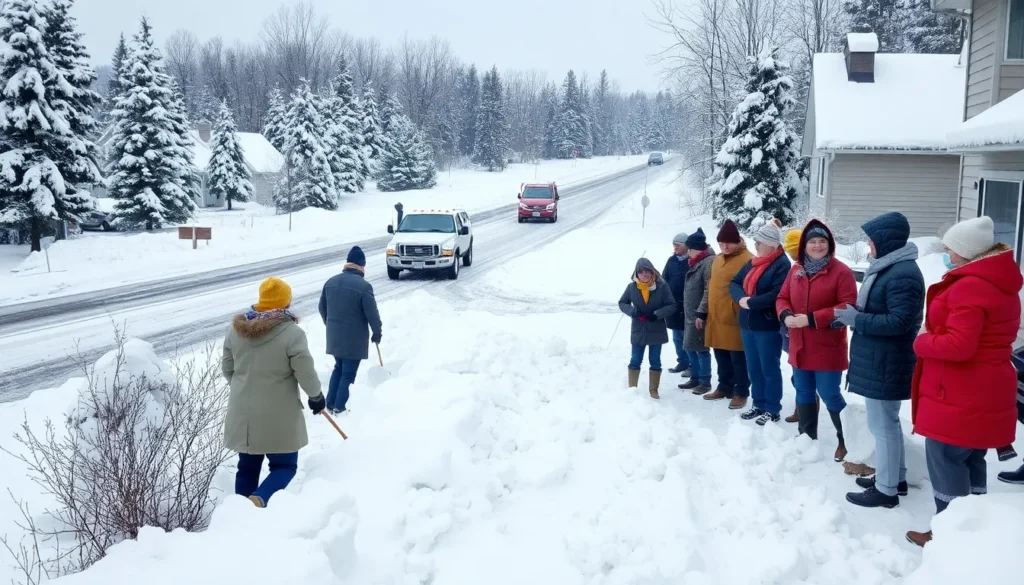Table of Contents
ToggleWhen the North Country declares a state of emergency, it’s not just a headline; it’s a call to action. Picture this: snowdrifts taller than your car, roads resembling ice rinks, and residents banding together like it’s a snow-themed reality show. As the winter wonderland transforms into a chaotic scene, understanding the implications of such emergencies becomes crucial.
In this article, readers will dive into what a state of emergency means for the North Country. From essential resources to community responses, it’s all hands on deck. So grab your hot cocoa and settle in; this isn’t just about surviving the snow—it’s about thriving in the face of winter’s wildest challenges.
Overview of the North Country State of Emergency
The North Country state of emergency responds to severe winter challenges. Heavy snowfall leads to treacherous road conditions, which often affect travel and transport. Communities face disruptions in power supply, making access to essential services critical. Emergency services prioritize safety during these conditions, working tirelessly to assist affected residents.
Preparedness is vital, as local authorities provide guidance and resources. Shelters may open in response to weather-related issues, ensuring residents have safe places to stay. Additionally, the local government implements snow removal strategies to maintain accessibility.
Residents demonstrate resilience through community actions. Neighbors help one another by clearing driveways and checking on vulnerable individuals. Local businesses frequently adjust their operations to accommodate community needs during these emergencies.
The impact of such situations extends beyond immediate challenges. Awareness of preparedness measures fosters long-term resilience, enabling communities to thrive despite adversity. Community programs emerge to educate individuals on how to handle extreme weather events. Collaboration between residents and authorities strengthens the regional response to future emergencies.
The North Country state of emergency underscores the importance of proactive measures and community solidarity. Individual preparedness efforts contribute significantly to overall safety during severe winter conditions. Through collective action and shared resources, communities navigate these challenges together.
Reasons for the Declaration

Several factors contribute to the declaration of a state of emergency in the North Country, particularly during severe winter events. Authorities focus on the immediate challenges faced by communities.
Weather Conditions
Severe winter weather remains a primary reason for declaring a state of emergency. Heavy snowfall can accumulate rapidly, often exceeding several feet in just days. Residents face hazardous driving conditions, while blizzards reduce visibility significantly. Icy roads also increase the risk of accidents and impede emergency response efforts. These extreme conditions prompt local officials to implement measures for public safety and prepare resources for affected residents.
Local Infrastructure Challenges
Local infrastructure often struggles to cope with severe winter challenges. Snow-covered roads hinder transportation routes, making it difficult for emergency services to reach those in need. Power outages frequently occur due to downed power lines caused by snow and ice accumulation. Shelters become essential for displaced individuals during such emergencies, requiring immediate coordination between local authorities and community organizations. The impact on public transport systems further complicates the situation, as delays and cancellations disrupt access to essential services.
Impact on Residents
Severe winter conditions during the North Country state of emergency significantly impact residents’ daily lives. The community faces various challenges as circumstances evolve.
Evacuations and Displacement
Evacuations become necessary when road conditions deteriorate, limiting access to homes. Displacement often occurs as residents seek shelter from hazardous weather. Shelters provide safe havens, allowing individuals and families to regroup. Coordination between local authorities and community organizations ensures resources are available for displaced individuals. Emergency responders assist with transportation to these shelters when needed. Maintaining clear communication about evacuation routes becomes crucial for safety and awareness. Many residents support each other, offering accommodation and assistance where possible.
Access to Essential Services
Access to essential services diminishes during severe weather events. Medical facilities must implement contingency plans to manage patient care amid transport disruptions. Residents face difficulty obtaining food and medication as supply lines become strained. Community organizations work diligently to provide food assistance and basic necessities. Authorities often prioritize road clearances to facilitate access to grocery stores and pharmacies. Local businesses adapt, providing delivery services to those unable to travel. Communication from local agencies keeps residents informed about available services and resources of assistance.
Response Efforts
Response efforts during the North Country state of emergency focus on coordinating resources and support for those affected by severe winter conditions.
Government Initiatives
Local authorities implement swift measures to address emergencies. Emergency services mobilize to clear roads and restore power. Resources such as shelters are established, enabling safe refuge for displaced residents. Communication channels stay open, ensuring that residents receive timely updates on road conditions and available assistance. Programs for rapid response promote winter safety education, raising awareness about preparedness measures. Collaborations with state agencies enhance resource allocation, improving overall response efficiency.
Community Support and Volunteerism
Community support thrives as residents rally to help one another. Neighbors assist in snow removal, fostering an environment of solidarity. Volunteers step up to distribute food and supplies to those in need, bridging gaps in access to essential services. Local businesses frequently adapt their operations, offering delivery services for groceries and medications. Various organizations coordinate efforts, pooling resources to provide comprehensive aid. Initiatives emerge encouraging individuals to check on vulnerable community members, highlighting the importance of togetherness during challenging times.
Future Considerations
Future measures focus on improving community resilience during winter emergencies. By enhancing preparedness, local residents can better navigate severe conditions.
Preparedness for Similar Events
Education on emergency response becomes vital for local communities. Training sessions could cover essential preparedness measures like creating emergency kits. Additionally, knowledge-sharing platforms provide resources for understanding weather alerts. Engaging youth in community drills fosters awareness. Coordinated neighborhood efforts, such as snow removal teams, also enhance readiness. Establishing strong communication networks ensures everyone stays informed during emergencies.
Policy Changes and Recommendations
Local authorities should consider updating emergency management policies. Implementing clear guidelines for activating states of emergency strengthens overall response capabilities. Prioritizing infrastructure improvements can lead to better traffic flow during winter storms. Introducing incentives for businesses to support community preparedness enhances collaboration. Furthermore, encouraging partnerships with non-profits ensures comprehensive resource allocation. Adaptation strategies will empower communities to effectively respond to future weather challenges.
The North Country state of emergency highlights the critical need for community resilience and preparedness during severe winter conditions. As residents face challenges like heavy snowfall and icy roads, the importance of collective action becomes evident. Local authorities and emergency services play vital roles in ensuring safety and providing essential resources.
The spirit of solidarity among community members shines through as they support one another in times of crisis. Looking ahead, fostering awareness and education on emergency response will strengthen the region’s ability to cope with future weather challenges. By prioritizing collaboration and infrastructure improvements, the North Country can enhance its readiness for whatever winter may bring.



